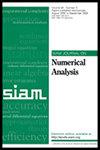An Explicit and Symmetric Exponential Wave Integrator for the Nonlinear Schrödinger Equation with Low Regularity Potential and Nonlinearity
IF 2.8
2区 数学
Q1 MATHEMATICS, APPLIED
引用次数: 0
Abstract
SIAM Journal on Numerical Analysis, Volume 62, Issue 4, Page 1901-1928, August 2024.Abstract. We propose and analyze a novel symmetric Gautschi-type exponential wave integrator (sEWI) for the nonlinear Schrödinger equation (NLSE) with low regularity potential and typical power-type nonlinearity of the form [math] with [math] being the wave function and [math] being the exponent of the nonlinearity. The sEWI is explicit and stable under a time step size restriction independent of the mesh size. We rigorously establish error estimates of the sEWI under various regularity assumptions on potential and nonlinearity. For “good” potential and nonlinearity ([math]-potential and [math]), we establish an optimal second-order error bound in the [math]-norm. For low regularity potential and nonlinearity ([math]-potential and [math]), we obtain a first-order [math]-norm error bound accompanied with a uniform [math]-norm bound of the numerical solution. Moreover, adopting a new technique of regularity compensation oscillation to analyze error cancellation, for some nonresonant time steps, the optimal second-order [math]-norm error bound is proved under a weaker assumption on the nonlinearity: [math]. For all the cases, we also present corresponding fractional order error bounds in the [math]-norm, which is the natural norm in terms of energy. Extensive numerical results are reported to confirm our error estimates and to demonstrate the superiority of the sEWI, including much weaker regularity requirements on potential and nonlinearity, and excellent long-time behavior with near-conservation of mass and energy.
低正则势能和非线性非线性薛定谔方程的显式对称指数波积分器
SIAM 数值分析期刊》,第 62 卷第 4 期,第 1901-1928 页,2024 年 8 月。 摘要。我们针对非线性薛定谔方程(NLSE)提出并分析了一种新颖的对称高齐型指数波积分器(sEWI),它具有低正则势能和典型的幂型非线性,其形式为[math],其中[math]为波函数,[math]为非线性指数。sEWI 在时间步长限制下是显式和稳定的,与网格大小无关。我们严格地建立了 sEWI 在电势和非线性的各种正则性假设下的误差估计。对于 "好的 "势能和非线性([math]-势能和[math]),我们建立了[math]-正则的最优二阶误差约束。对于低正则性势能和非线性([math]-势能和[math]),我们得到了一阶[math]-正则误差约束以及数值解的均匀[math]-正则约束。此外,对于某些非共振时间步长,我们还采用了一种新的正则补偿振荡技术来分析误差消除,并在非线性假设较弱的情况下证明了最优的二阶[math]-正则误差约束:[math]。对于所有情况,我们还提出了相应的分数阶[math]规范误差约束,这是能量方面的自然规范。我们报告了大量的数值结果,以证实我们的误差估计,并证明 sEWI 的优越性,包括对势能和非线性的正则性要求要弱得多,以及质量和能量近乎守恒的出色长时行为。
本文章由计算机程序翻译,如有差异,请以英文原文为准。
求助全文
约1分钟内获得全文
求助全文
来源期刊
CiteScore
4.80
自引率
6.90%
发文量
110
审稿时长
4-8 weeks
期刊介绍:
SIAM Journal on Numerical Analysis (SINUM) contains research articles on the development and analysis of numerical methods. Topics include the rigorous study of convergence of algorithms, their accuracy, their stability, and their computational complexity. Also included are results in mathematical analysis that contribute to algorithm analysis, and computational results that demonstrate algorithm behavior and applicability.

 求助内容:
求助内容: 应助结果提醒方式:
应助结果提醒方式:


